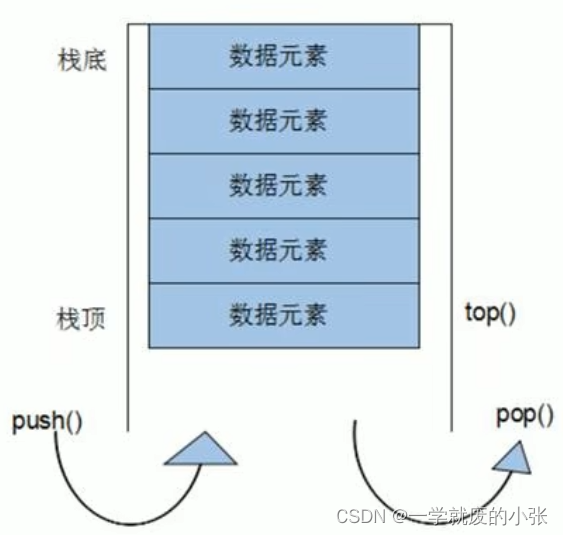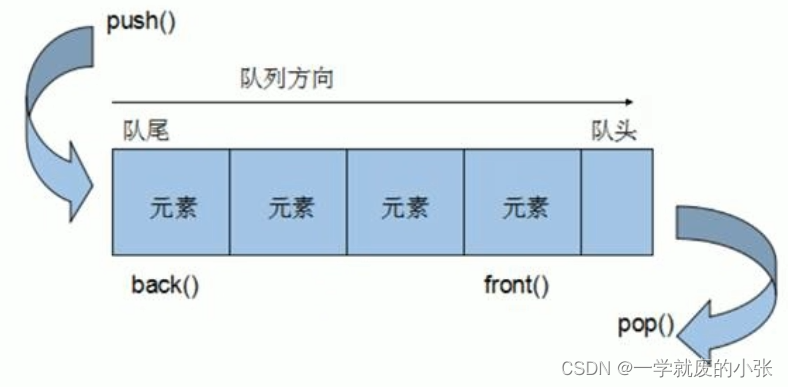C++学习笔记(二十)
一、stack容器
1. stack基本概念
概念:stack是一种先进后出(First In Last Out,FILO)的数据结构,它只有一个出口

?栈中只有顶端的元素才可以被外界使用,因此栈不允许有遍历行为
栈中进入数据称为 —— 入栈 push
栈中弹出数据称为 —— 出栈 pop
2. stack常用接口
构造函数:
- stack<T> stk;? ? ? ? // stack采用模板类实现,stack对象的默认构造形式
- stack(const stack &stk);? ? ? ? // 拷贝构造
赋值操作:
- stack& operator=(const stack &stk);? ? ? ? // 重载等号操作符
数据存取:
- push(elem);? ? ? ? // 向栈顶添加元素
- pop();? ? ? ? // 从栈顶移除第一个元素
- top();? ? ? ? // 返回栈顶元素
大小操作:
- empty();? ? ? ? // 判断堆栈是否为空
- size();? ? ? ? // 返回栈的大小
#include <iostream>
#include <stack>
using namespace std;
void test01()
{
stack<int>s;
// 入栈
s.push(10);
s.push(20);
s.push(30);
s.push(40);
s.push(50);
// 查看栈的大小
cout << "栈的大小为:" << s.size() << endl;
// 只要栈不为空,查看栈顶,并且执行出栈操作
while (!s.empty())
{
// 查看栈顶元素
cout << "栈顶元素为:" << s.top() << endl;
// 出栈
s.pop();
}
cout << "栈的大小为:" << s.size() << endl;
}
int main(int argc, char* argv[])
{
test01();
return 0;
}二、queue容器
1. queue基本概念
概念:queue是一种先进先出(First In First Out,FIFO)的数据结构,他有两个出口

队列容器允许从一端新增元素,从另一端移除元素
队列中只有队头和队尾才能被外界使用,因此队列不允许有遍历行为
队列中进数据称为 —— 入队 push
队列中出数据称为 —— 出队 pop
2. queue常用接口
构造函数:
- queue<T> que;? ? ? ? // queue采用模板类实现,queue对象的默认构造形式
- queue(const queue &que);? ? ? ? // 拷贝构造函数
赋值操作:
- queue& operator=(const queue &que);? ? ? ? // 重载等号操作符
数据存取:
- push(elem);? ? ? ? // 往队尾添加元素
- pop();? ? ? ? // 从队头移除第一个元素
- back();? ? ? ? // 返回最后一个元素
- front();? ? ? ? // 返回第一个元素
大小操作:
- empty();? ? ? ? // 判断队列是否为空
- size();? ? ? ? // 返回队列的大小
#include <iostream>
#include <queue>
#include <string>
using namespace std;
class Person
{
public:
Person(string name, int age)
{
this->m_Name = name;
this->m_Age = age;
}
string m_Name;
int m_Age;
};
void test01()
{
// 创建队列
queue<Person>q;
// 准备数据
Person p1("刘备", 50);
Person p2("关羽", 40);
Person p3("张飞", 30);
Person p4("赵云", 20);
// 入栈
q.push(p1);
q.push(p2);
q.push(p3);
q.push(p4);
// 查看队列的大小
cout << "栈的大小为:" << q.size() << endl;
// 只要队列不为空,查看队头队尾,并且执行出队操作
while (!q.empty())
{
cout << "----------------" << endl;
// 查看队头队尾元素
cout << "队头:" << endl;
cout << "姓名:" << q.front().m_Name << " " << "年龄:" << q.front().m_Age << endl;
cout << "队尾:" << endl;
cout << "姓名:" << q.back().m_Name << " " << "年龄:" << q.back().m_Age << endl;
// 出队
q.pop();
}
cout << "队列的大小为:" << q.size() << endl;
}
int main(int argc, char* argv[])
{
test01();
return 0;
}三、list容器
1. list基本概念
功能:将数据进行链式存储
链表(list)是一种物理存储单元上非连续的存储结构,数据元素的逻辑顺序是通过链表中的指针链接实现的
链表的组成:链表是由一系列结点组成
结点的组成:一个是存储元素的数据域,另一个是存储下一个节点地址的指针域
STL中的链表是一个双向循环链表

?由于链表的存储方式并不是连续的内存空间,因此链表list中的迭代器只支持前移和后移,属于双向迭代器
list的优点:
- 采用动态存储分配,不会造成内存浪费和溢出
- 链表执行插入和删除操作十分方便,修改指针即可,不需要移动大量元素
list的缺点:
- 链表灵活,但是空间(指针域)和时间(遍历)额外耗费较大
list有一个重要的性质,插入操作和删除操作都不会造成原有的list迭代器失效,这在vector是不成立的
总结:STL中list和vector是两个最常被使用的容器,各有优缺点
2. list构造函数
函数原型:
list<T> lst;? ? ? ? // list采用模板类实现,对象的默认构造形式
list(beg, end);? ? ? ? // 构造函数将[beg, end)区间中的元素拷贝给本身
list(n, elem);? ? ? ? // 构造函数将n个elem拷贝给本身
list(const list &lst);? ? ? ? // 拷贝构造函数
#include <iostream>
#include <list>
using namespace std;
void printList(list<int>& l)
{
for (list<int>::iterator it = l.begin(); it != l.end(); it++)
{
cout << *it << " ";
}
cout << endl;
}
void test01()
{
list<int> l1;
for (int i = 0; i < 10; i++)
{
l1.push_back(i);
}
printList(l1);
list<int> l2(l1.begin(), l1.end());
printList(l2);
list<int> l3(10, 100);
printList(l3);
list<int> l4(l3);
printList(l4);
}
int main(int argc, char* argv[])
{
test01();
return 0;
}3. list赋值与交换
函数原型:
assign(beg, end);? ? ? ? // 将[beg, end)区间中的数据拷贝复制给本身
assign(n, elem);? ? ? ? // 将n个elem拷贝复制给本身
list& operator=(const list &lst);? ? ? ? // 重载等号操作符
swap(lst);? ? ? ? // 将lst与本身的元素交换
#include <iostream>
#include <list>
using namespace std;
void printList(list<int>& l)
{
for (list<int>::iterator it = l.begin(); it != l.end(); it++)
{
cout << *it << " ";
}
cout << endl;
}
void test01()
{
list<int> l1;
for (int i = 0; i < 10; i++)
{
l1.push_back(i);
}
printList(l1);
list<int> l2;
l2 = l1;
printList(l2);
list<int> l3;
l3.assign(l2.begin(), l2.end());
printList(l3);
list<int> l4;
l4.assign(10, 100);
printList(l4);
list<int> l5;
l5.push_back(1);
l5.push_back(1);
l5.push_back(1);
l5.push_back(1);
l5.push_back(1);
cout << "交换前:" << endl;
cout << "l4:";
printList(l4);
cout << "l5:";
printList(l5);
l5.swap(l4);
cout << "交换后:" << endl;
cout << "l4:";
printList(l4);
cout << "l5:";
printList(l5);
}
int main(int argc, char* argv[])
{
test01();
return 0;
}4. list大小操作
函数原型:
size();? ? ? ? // 返回容器中元素的个数
empty();? ? ? ? // 判断容器是否为空
resize(num);? ? ? ? // 重新指定容器的长度为num,若容器变长,则以默认值填充新位置
? ? ? ? ? ? ? ? ? ???????? ?// 如果容器变短,则末尾超出容器长度的元素被删除
resize(num, elem);? ? ? ? // 重新指定容器的长度为num,若容器变长,则以elem填充新位置
? ? ? ? ? ? ? ? ? ? ? ? ? ? ? ? ? ?? ?// 如果容器变短,则末尾超出容器长度的元素被删除
#include <iostream>
#include <list>
using namespace std;
void printList(list<int>& l)
{
for (list<int>::iterator it = l.begin(); it != l.end(); it++)
{
cout << *it << " ";
}
cout << endl;
}
void test01()
{
list<int> l1;
l1.push_back(10);
l1.push_back(20);
l1.push_back(30);
l1.push_back(40);
l1.push_back(50);
printList(l1);
// 判断容器是否为空
if (l1.empty())
{
cout << "l1为空..." << endl;
}
else
{
cout << "l1不为空..." << endl;
cout << "l1的元素个数为:" << l1.size() << endl;
}
// 重新指定大小
l1.resize(10);
printList(l1);
l1.resize(20, 100);
printList(l1);
l1.resize(2);
printList(l1);
}
int main(int argc, char* argv[])
{
test01();
return 0;
}5. list插入和删除
函数原型:
push_back(elem);? ? ? ? // 在容器尾部添加一个元素
pop_back();? ? ? ? // 删除容器中最后一个元素
push_front(elem);? ? ? ? // 在容器开头插入一个元素
pop_front();? ? ? ? // 从容器开头移除第一个元素
insert(pos, elem);? ? ? ? // 在pos位置插入elem元素的拷贝,返回新数据的位置
insert(pos, n, elem);? ? ? ? // 在pos位置插入n个elem数据,无返回值
insert(pos, beg, end);? ? ? ? // 在pos位置插入[beg, end)区间的数据,无返回值
clear();? ? ? ? // 移除容器中的所有数据
erase(beg, end);? ? ? ? // 删除[beg, end)区间的数据,返回下一个数据的位置
erase(pos);? ? ? ? // 删除pos位置的数据,返回下一个数据的位置
remove(elem);? ? ? ? // 删除容器中所有与elem值匹配的元素
#include <iostream>
#include <list>
using namespace std;
void printList(list<int>& l)
{
for (list<int>::iterator it = l.begin(); it != l.end(); it++)
{
cout << *it << " ";
}
cout << endl;
}
void test01()
{
list<int> l1;
// 尾插
l1.push_back(10);
l1.push_back(20);
l1.push_back(30);
l1.push_back(40);
l1.push_back(50);
printList(l1);
// 头插
l1.push_front(100);
l1.push_front(200);
l1.push_front(300);
printList(l1);
// 尾删,头删
l1.pop_back();
l1.pop_front();
printList(l1);
// 插入
list<int>::iterator it = l1.begin();
l1.insert(++(++it), 1000);
printList(l1);
// erase删除
it = l1.begin();
l1.erase(it);
printList(l1);
// remove删除
l1.push_back(1000);
printList(l1);
l1.remove(1000);
printList(l1);
// 清空
l1.clear();
printList(l1);
}
int main(int argc, char* argv[])
{
test01();
return 0;
}6. list数据存取
函数原型:
front();? ? ? ? // 返回第一个元素
back();? ? ? ? // 返回最后一个元素
#include <iostream>
#include <list>
using namespace std;
void printList(list<int>& l)
{
for (list<int>::iterator it = l.begin(); it != l.end(); it++)
{
cout << *it << " ";
}
cout << endl;
}
void test01()
{
list<int> l1;
l1.push_back(10);
l1.push_back(20);
l1.push_back(30);
l1.push_back(40);
l1.push_back(50);
printList(l1);
cout << "第一个元素是:" << l1.front() << endl;
cout << "最后一个元素是:" << l1.back() << endl;
// 验证迭代器是不支持随机访问的
list<int>::iterator it = l1.begin();
// 支持双向
cout << *++it << endl;
cout << *--it << endl;
// it = it + 1; 不支持随机访问
}
int main(int argc, char* argv[])
{
test01();
return 0;
}7. list反转和排序
函数原型:
reverse();? ? ? ? // 反转链表
sort();? ? ? ? // 排序链表
#include <iostream>
#include <list>
#include <algorithm>
using namespace std;
void printList(list<int>& l)
{
for (list<int>::iterator it = l.begin(); it != l.end(); it++)
{
cout << *it << " ";
}
cout << endl;
}
bool myCompare(int num1, int num2)
{
return num1 > num2;
}
void test01()
{
list<int> l1;
l1.push_back(20);
l1.push_back(50);
l1.push_back(30);
l1.push_back(10);
l1.push_back(40);
cout << "排序前:";
printList(l1);
// 排序
// 所有不支持随机访问迭代器的容器,不可以用标准算法
// 不支持随机访问迭代器的容器,内部会提供对应的一些算法
l1.sort(); // 默认排序规则,从小到大,升序
cout << "升序排序后:";
printList(l1);
l1.sort(myCompare); // 默认排序规则,从小到大,升序
cout << "降序排序后:";
printList(l1);
cout << "反转前:";
printList(l1);
// 反转
l1.reverse();
cout << "反转后:";
printList(l1);
}
int main(int argc, char* argv[])
{
test01();
return 0;
}8. list排序案例
案例描述:将Person自定义数据类型进行排序,Person中属性有姓名,年龄,身高
排序规则:按照年龄进行升序排序,如果年龄相同贼按照身高进行降序排序
#include <iostream>
#include <list>
#include <string>
#include <algorithm>
using namespace std;
class Person
{
public:
Person(string name, int age, int height)
{
this->m_Name = name;
this->m_Age = age;
this->m_Height = height;
}
string m_Name;
int m_Age;
int m_Height;
};
// 指定排序规则
bool comparePerson(Person& p1, Person& p2)
{
if (p1.m_Age == p2.m_Age)
{
return p1.m_Height > p2.m_Height;
}
return p1.m_Age < p2.m_Age;
}
void test01()
{
// 创建list容器
list<Person>l;
// 准备数据
Person p1("刘备", 35, 175);
Person p2("曹操", 45, 180);
Person p3("孙权", 40, 170);
Person p4("赵云", 25, 190);
Person p5("张飞", 35, 160);
Person p6("关羽", 35, 200);
// 插入数据
l.push_back(p1);
l.push_back(p2);
l.push_back(p3);
l.push_back(p4);
l.push_back(p5);
l.push_back(p6);
// 排序前
cout << "——————排序前——————" << endl;
for (list<Person>::iterator it = l.begin(); it != l.end(); it++)
{
cout << "姓名:" << (*it).m_Name << " " << "年龄:" << it->m_Age << " " << "身高:" << it->m_Height << endl;
}
// 排序后
l.sort(comparePerson);
cout << "——————排序后——————" << endl;
for (list<Person>::iterator it = l.begin(); it != l.end(); it++)
{
cout << "姓名:" << (*it).m_Name << " " << "年龄:" << it->m_Age << " " << "身高:" << it->m_Height << endl;
}
}
int main(int argc, char* argv[])
{
test01();
return 0;
}本文来自互联网用户投稿,该文观点仅代表作者本人,不代表本站立场。本站仅提供信息存储空间服务,不拥有所有权,不承担相关法律责任。 如若内容造成侵权/违法违规/事实不符,请联系我的编程经验分享网邮箱:chenni525@qq.com进行投诉反馈,一经查实,立即删除!
- Python教程
- 深入理解 MySQL 中的 HAVING 关键字和聚合函数
- Qt之QChar编码(1)
- MyBatis入门基础篇
- 用Python脚本实现FFmpeg批量转换
- 神经网络分类模型的评价函数和曲线图
- CC工具箱使用指南:【赋值用地用海编码和名称】
- java springboot将接口查询数据放在系统中 一小时系统更新一次 避免用户访问接口查询数据库缓慢
- Pytest框架 之【用例执行顺序】
- 【WPF.NET开发】WPF中的文档
- 邮政快递查询,邮政快递单号查询,筛选出指定派件员的单号
- 第02章_变量与进制
- 微认证 openEuler社区开源贡献实践
- 手把手教你用 Stable Diffusion 写好提示词
- 文件内容采集-go